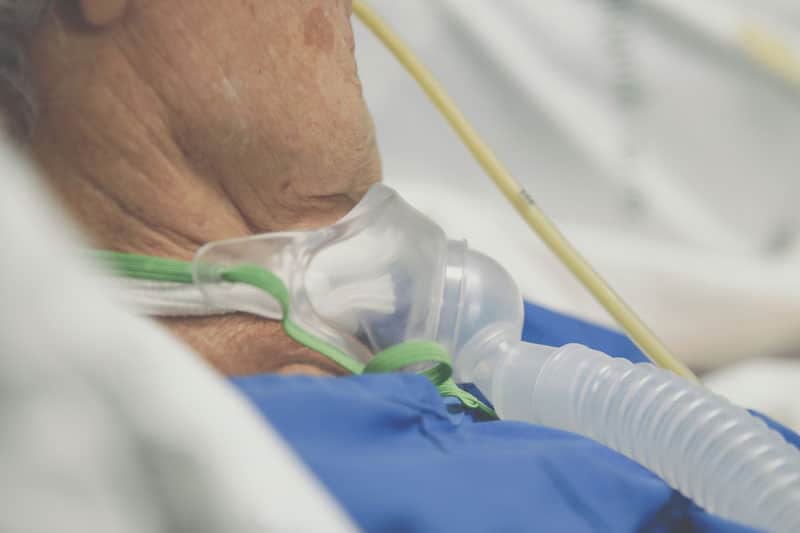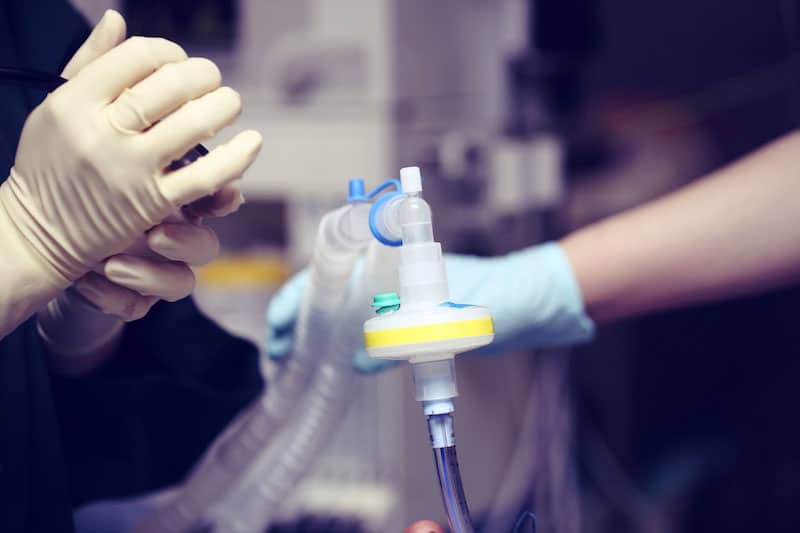When a person you care about needs a tracheostomy, you may have a lot of questions. How is this procedure done, and why is it necessary? What type of care does a person need after a tracheostomy? What can your loved one expect when the surgery is done? To help you learn more about tracheostomies and how to prepare, our Arizona respiratory care experts explain what you need to know.
What Is a Tracheostomy Procedure?

A tracheostomy involves a surgical procedure to create an opening in the neck and windpipe (tracheotomy) where a tube is placed. This tube allows air to flow into the lungs without having to travel through the nose, mouth or throat.
Often referred to as a “stoma” or “trach,” the procedure is relatively quick, whether planned or performed during an emergency. Special care is needed after a tracheostomy to ensure the patient is comfortable and does not develop an infection or other complications.
Why Would a Person Need a Tracheostomy?
There are several reasons why a person may need a tracheostomy. When a person’s airway is restricted, it can be incredibly dangerous or even fatal. Sometimes, the airway becomes blocked over time due to an illness or disease. Other times, an emergency situation makes it difficult or impossible to breathe.
According to the American Thoracic Society (ATS)1, some respiratory conditions that could result in a tracheostomy include:
- Anaphylaxis
- Severe mouth or neck injuries
- Airway or facial burns
- Cancer in the neck or throat
- Infections or injuries of the larynx
- Paralysis of muscles needed for swallowing
- Paralysis of the vocal cords
- Severe sleep apnea
- Chest wall injuries
- Chronic lung disease
- Diaphragm issues
- Coma
- Ongoing respiratory or ventilator support
A tracheostomy provides an effective, more comfortable and accessible way to breathe for individuals with these conditions. How long a person needs a tracheostomy depends on the severity of the condition and whether or not it is treatable. Your healthcare provider should give you an idea of when and if the tracheostomy tube can be removed.

How Is a Tracheostomy Performed?
For patients with a scheduled procedure, your doctor will use general anesthesia. This means you will be asleep during the surgery and will not feel any discomfort as it is happening. However, if it is an emergency, local anesthesia is sometimes necessary to numb the area of the neck where the incision will take place.
Although there may be some variations to the procedure depending on the circumstances, a tracheostomy involves these steps:
- A tracheotomy – a surgeon makes a small cut in the neck through the cartilaginous rings in the trachea.
- The opening is dilated to create a hole in which the tracheostomy tube is fitted.
- In many cases, a ventilator is then connected to the tube to help the patient breathe.
- A sterile and secure band goes around the neck to keep the tube in place.
After the surgery is complete, the patient is given time to recover. However, they may need skilled nursing care to reach a full recovery or for ongoing respiratory care.
Contact our Haven Health team to learn about our respiratory care services in Tucson, AZ, and how we can help you on your road to recovery.
Are There Risks With a Tracheostomy?
As with any surgical procedure, there are some risks associated with a tracheostomy. According to an article published in the International Journal of Critical Illness and Injury Science2, tracheostomy risks include:
- Pneumothorax
- Hemorrhage
- Tube misplacement/displacement
- Tracheal perforation
- Thyroid injury
- Recurrent laryngeal nerve injury
- Subcutaneous emphysema
- Infection
- Tracheoesophageal fistula
- Tracheal stenosis
- Delayed closure of the wound
- Weakening of the tracheal wall
- Change in voice
Some of these risks are very rare complications and have a low occurrence rate. However, it’s always best to discuss any risks with your doctor to understand the details of the procedure.
Related: What is Tracheostomy Care?
What Are the Benefits of a Tracheostomy Procedure?
In most cases, the benefits of a tracheostomy outweigh the minimal risks of the surgery or leaving patients in their current state. Although there may be alternatives to this procedure for some patients, including an endotracheal tube (or breathing tube that goes through the mouth), here are the benefits of a tracheostomy1:
- Less risk of mouth ulcers and vocal cord damage than an endotracheal tube.
- Tracheostomies are more comfortable for patients versus a long tube that enters through the mouth.
- Many patients require less pain medication than with an endotracheal tube, making it easier to communicate and remain alert.
- Tracheostomy tubes can often remain in place safely for more extended periods of time than an endotracheal tube.
- Tracheostomy tubes are secure enough for patients to be more mobile and participate in physical therapy, occupational therapy or other rehabilitation activities.
Haven Health in Tucson offers specialized tracheostomy care to help you or a loved one recover after leaving the hospital. Contact us to learn more.
How To Prepare for a Tracheostomy
Your healthcare provider will share what you or your loved one should do to prepare for the tracheostomy procedure. However, there are some things to keep in mind. You’ll probably be receiving general anesthesia that will put you to sleep during the surgery. This means you will most likely need to refrain from eating and drinking prior to the tracheostomy.
Also, you may need to be in the hospital for a few days as you recover. Things that may help you feel more comfortable during this time include comfortable clothing, a robe, slippers and personal toiletry items. You may want to bring things that could help pass the time, such as books, magazines or other types of entertainment.
After a tracheostomy, it will be difficult to communicate right away. Many tracheostomy patients need rehabilitation, speech therapy and other forms of support to interact with their loved ones and hospital staff. It’s essential to understand this and mentally prepare before going in for the procedure.
What Type of Care Is Needed After a Tracheostomy?

Many patients require specialized care after a tracheostomy because the body needs time to heal and adjust. Tracheostomy patients will need support with:
- Cleaning and changing the tracheostomy tube. It’s crucial that the tube is cleaned and changed the right way to avoid infections and other complications.
- Eating. Swallowing will be a challenge right after a tracheostomy procedure. It will take time for the muscles to regain the strength and coordination necessary for eating.
- Speaking. There are special devices and techniques that allow trach patients to communicate with others. However, a speech therapist and other support staff will need to help.
- Combatting the effects of dry air. Because air no longer passes through the mouth or nose, it is quite dry when it reaches the lungs. This dry air can lead to several issues, including coughing and irritation. Skilled nurses can help with a saline nebulizer, humidifier or other treatments.
Patients who receive a tracheostomy are often dealing with other health issues, such as illness or complications associated with injuries or old age. That’s why it’s crucial to get the right post-hospital care for a successful recovery or safe return home.
Tracheostomy Care and Respiratory Therapy at Haven Health
At Haven Health in Tucson, our new Respiratory Care Unit specializes in helping patients by providing compassionate ventilator and tracheostomy care. We offer in-room oxygen, medical air and suction in both our semi-private and private rooms. Our vascular access team, round-the-clock respiratory therapy and top-of-the-line innovative equipment ensure we can produce the best patient outcomes.
Together, our patients and their families enjoy quality care during their time with us, in an environment we are proud to share. To learn more about our dedicated Respiratory Care Unit in Tucson, Arizona, contact our skilled nursing team today.
Sources:
1Anuj B Mehta, MD; Sohera N Syeda MD; Allan J Walkey, MD MSc; Renda S Wiener, MD MPH. (2016). Tracheostomy in Adults. American Thoracic Society. Am J Respir Crit Care Med Vol. 194, P3-P4. Retrieved 19 October 2021
2Cipriano, A., Mao, M. L., Hon, H. H., Vazquez, D., Stawicki, S. P., Sharpe, R. P., & Evans, D. C. (2015). An overview of complications associated with open and percutaneous tracheostomy procedures. International journal of critical illness and injury science, 5(3), 179–188. Retrieved 19 October 2021